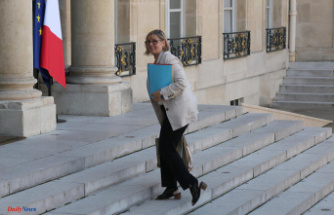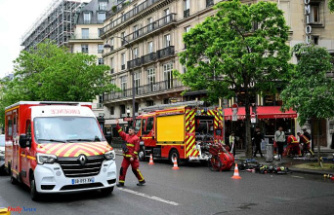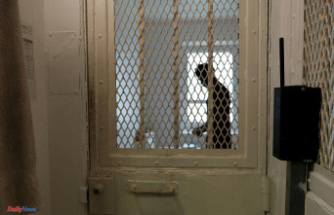Together artists carry a roof. It doesn't matter which art direction they represent, which religion they belong to and which continent they come from. Sound crazy? Not at all - the result is in the middle of the Bavarian countryside near Polling and is called Stoa169. Stoa - how? Behind it is a columned hall that is almost a small world exhibition. Amazement included, because in addition to painted columns there are also specimens made of bone. Plus a plane tree, a kayak, a match and even a cucumber. The 121 columns were designed by stars, strangers or art students. In addition, the work of art is open around the clock and can be visited without admission. Here the much-vaunted democratization of art comes to the point. The painter Bernd Zimmer had the inspiration for Stoa169 on a journey through India 30 years ago and finally realized it. He met up with ntv.de for a tour of this amazing and enjoyable art experience. In the interview he talks about stubbornness, closeness to nature, the advantage of home, beer and the new wild ones.
n-tv: You rolled over the dream of the Stoa169 for 30 years - was there a low point?
Bernd Zimmer: Yes, by 2004 I had come to terms with not realizing the idea of the artists' columned hall. In 2015, the idea suddenly resurfaced in my head. Finally I persuaded my wife Nina to go to India with me again. On site in Tiruchirappalli we decided to take the risk. Funding has been the main problem.
Supposedly you had to collect six million euros from various sponsors?
In the end we got off a little cheaper. But the Stoa169 is worth much more and I am happy that the artists generously participated and did not ask their market prices. We funded each sculpture and also did all the work on the pillars. The artists only received a kind of cancellation fee.
Why did the artists take part in this curious idea? Was that your power of persuasion?
No, I think they really liked that. This equal coexistence, the long-term thinking has convinced. Everything remains immovable as it is now installed. And at the same time, it shows art that was produced both analogously and digitally. The art world is changing right now.
With the pillars you depict the current state of the art world. This underscores the meaningfulness of the Stoa169 even more. How many beers did you have to drink with the Pollingers to convince them of your project?
Beforehand, it was good to be a local and of course you had to have a few beers (laughs). There were only a few major discussions at the regulars' table. However, I was very lucky to get this piece of land on the Ammer. The fact that I've been settled and at home here for a long time was helpful. The land wasn't for sale, but I know farming people, so one thing led to another. I was given the condition that the rest of the land that is not built on is used for agriculture, which I wanted anyway.
The hall is very picturesquely embedded in the landscape and can only be reached on foot. Nature is also a huge theme in your paintings.
It's been my main theme since the 80's. How is the relationship between us humans in nature? We are beneficiaries of the beautiful nature and a part of it. That we are the masters of animals and nature is nonsense. You have to put everything in context. We are lucky to live on this privileged planet.
You have made a name for yourself as a so-called New Wilder in the arts. Together with others you were on the move as a figurative painter at a time when abstraction was the measure of all things. What did you learn back then that you could apply to the realization of the Stoa169?
I did an apprenticeship as a publishing bookseller and also worked as such because my parents wanted a decent job. At the age of 28 I finally threw myself into painting. If you want to work as an artist, you need insane tenacity and a kind of stubbornness. Adaptation would be absolutely wrong. You have to follow an idea and if it makes sense, you can tell it productively with your pictures for a long time. Painting develops and becomes independent, you have to tame it again and again and develop a new narrative thread. At the beginning of this painting, so in the early 80s, we banged on the plaster and just let the paint explode. At that time, grey-brown tones were more popular in painting.
That was new and different. Are you a merciless idealist?
Exactly. That has something of Hegelian idealism, paired with the will to go through with it. And a bit of entrepreneurial spirit is part of it. In the Stoa it is clearly formulated what I mean by a democratic image. A lot of people have to play along, that's only possible in a team. When I paint a picture, it's pure individualism.
Is persistence and a bit of madness your recipe for success?
I think all artists who are persistent in their work have a little bit of madness in them (laughs). At the same time, you mustn't let yourself be distracted, because the pictures you paint should reach the public. With a picture I tell either the story of colour, non-colour, abstraction, arbitrariness or gesture. It is thought processes that become visible and thus take on a form. If you recognize a tree in my painting, the picture also tells the story of how I think about nature.
You are the figurative painter who realized a huge conceptual artwork for everyone. Does it annoy you that you suddenly disappear behind the actual work that you created as a painter?
What I have been doing for 50 years, namely working as an artist and painter, is the fruitful humus. Only out of and in him could the great, namely the Stoa169, arise. With this super concept, I probably put myself above myself as a painter, but I don't feel that way. The risk of failing with the Stoa169 was great. However, I have had a lot of success with my painting. I think you have to give back what you get from art. Do not hoard or accumulate, whether it be money or possessions. I like to give something back. I find giving gifts at least as good as receiving gifts. That gives me great pleasure. It may be idealism or Confucianism, in any case it is the right path for me.
Is painting going down this path again? The Stoa169 is almost finished and the book for it has just come onto the market.
I kept painting. In the morning I wrote letters about the Stoa169 case and made sure that I could get back in front of the screen. I slipped out of what was happening in the gallery a bit because I also had other things to do.
Do you wish that the painter Bernd Zimmer would become more visible again and that the Stoa would fuel that?
People should make an effort to see both at the same time. The Stoa169 is a parallel story and was an attempt to implement and represent a democratic idea. An attempt that was successful because people who don't normally go to the museum can also go.
Has your painting changed over the Stoa project?
I learned from the many different artists. Their way of thinking gave my painting a boost. This year I painted very beautiful, large, almost monochrome paintings that are very painterly. In the end, my work should tell a big story.
So you're not done yet?
No, I certainly won't put down my brush.
Juliane Rohr spoke to Bernd Zimmer
Stoa169 in 82398 Polling - how to get there.












